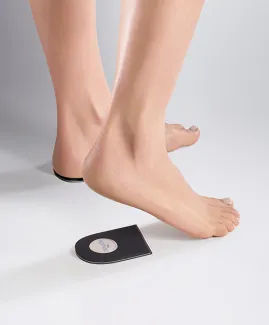
You have probably heard about plantar fasciitis and heel spur, both very frequent foot conditions. Indeed, they are very common reasons for consultation and are responsible for most heel pains.
They are often confused because of their symptoms but, are they really the same? EPITACT® dispels the doubt and explains to you the differences between heel spurs vs plantar fasciitis.
Plantar fasciitis, heel spur: definition
To understand the context from which these conditions occur, let’s define first what is the plantar fascia and plantar fasciitis vs a heel spur.
What is the plantar fascia?
The plantar fascia, aka plantar aponeurosis, is a thick fibrous membrane located on the bottom of the foot. It connects the calcaneus (heel bone) and the base of the first phalanges of the toes(1).
It is a dense and not very elastic tissue mainly composed of collagen. With age, especially because of hormonal changes in women, the collagen level can decrease and may weaken the plantar fascia.
As a consequence, it is less effective in supporting the foot daily and it can cause it damage. Note that age is not the only cause for this.
The plantar fascia has several roles, of which the most important is to support the arch of the foot. It also absorbs the impact of the foot on the ground and transmits the forces of the calf muscles (triceps surae muscles to move forwards. Also, the plantar fascia contributes to bearing the body weight and reduces excessive and repeated pressure points under the foot.
What is plantar fasciitis vs a heel spur?
Plantar fasciitis is the inflammation of the plantar fascia. It has several names like ‘plantar fasciopathy’ or ‘plantar fasciosis’. This variety of names results from a disagreement about the meaning and cause of this condition. Indeed, certain studies explain it is more the degeneration of the fascia rather than its inflammation(1).
Most of the time, pain manifests where the plantar fascia attaches to the heel bone (enthesis): it is also called plantar fascia enthesopathy(2). However, pain can also appear at the centre of the fascia, this is why we usually say there are two types of plantar fasciitis.
Heel spur is sometimes referred to as ‘calcaneal spur’, ‘bone spur’, ‘osteophyte’ or sometimes ‘enthesophyte’. It corresponds to a calcium deposit that causes a small pointed bony protrusion at the inferior base of the calcaneus, especially where the plantar fascia connects.
Are the symptoms of plantar fasciitis and heel spurs the same?
Generally, the pain from plantar fasciitis is shooting and more acute in the morning or at the end of the day(3). As we have just said, pain can be localised under the heel or may spread under the arch of the foot.
On the contrary, all heel spurs are not painful: 30% of the population would be asymptomatic(2).
Plantar fasciitis vs heel spur: what causes them?
Plantar fasciitis is mainly due to mechanical overuse of the plantar fascia. Indeed, excessive and repeated pressures accelerate the onset of the condition. For example, while running or walking, the repeated foot impact on the ground increases the stress on the insertion point of the plantar fascia, which can lead to microtears and microtraumas.
This consequently triggers an inflammatory response, which favours fibrosis, degeneration and thickening of the plantar fascia(1). The latter becomes less elastic and effective.
The resulting microtraumas and inflammation boost the formation of bone cells responsible for heel spurs. This bone excrescence grows progressively by calcification of cells in order to protect the area from the stress related to plantar fasciitis.
Such overuse of the plantar fascia is higher in people with flat feet in a valgus position, which deform the arch of the foot and may progressively cause plantar fasciitis because of excessive stress. Same process in people who are overweight or practising sports like running, which lead to recurrent shocks between the foot and ground.
So, what is the difference between heel spurs and plantar fasciitis?
You have understood that plantar fasciitis and heel spurs are not the same but they are related regarding their symptoms, causes and risk factors.
Can plantar fasciitis cause a heel spur? Or do heel spurs cause plantar fasciitis?
The truth is that one doesn’t necessarily cause the other but most of the time, plantar fasciitis causes a heel spur. This is the inflammation of the plantar fascia that leads to the formation of a heel spur to strengthen the affected area.
In turn, the heel spur feeds the inflammatory response. Heel spurs generally cause microtraumas of the plantar fascia but, in rarer cases, it may lead to its complete rupture. We could say that heel spurs are a consequence of plantar fasciitis. By the way, X-Ray reveals the presence of a heel spur in 45 to 85% of people who consult for plantar fasciitis(4).
Plantar fasciitis vs heel spurs: how to relieve them?
If you have such a pain in your heel, think about consulting your general practitioner. He/She gives advice on the solutions available to relieve you. Anyway, in case of plantar fasciitis or heel spurs, it is recommended to stretch the plantar fascia in order to limit the stress on it.
As a complement to physical therapy including stretching exercises of the plantar fascia, you can wear the EPITACT®heel lifts* composed of a shock absorbing material and a silicone gel cushion. They will relieve your foot pain and limit the inflammation. Do not hesitate to read our other articles at the end of the page dedicated to plantar fasciitis and heel spur.
*This solution is a class I medical device that bears the CE marking under this regulation. Carefully read the instructions before use. Manufacturer: Millet Innovation. 07/2023
For more details about this general and simplified approach, here are further sources:
(1)Hasegawa, Morgan, Ivan Urits, Vwaire Orhurhu, Mariam Salisu Orhurhu, Joseph Brinkman, Stephen Giacomazzi, Lukas Foster, et al. « Current Concepts of Minimally Invasive Treatment Options for Plantar Fasciitis: A Comprehensive Review ». Current Pain and Headache Reports 24, no 9 (September 2020): 55. https://doi.org/10.1007/s11916-020-00883-7.55. https://doi.org/10.1007/s11916-020-00883-7.
(2)Alatassi, Raheef, Ahmad Alajlan, et Talal Almalki. « Bizarre Calcaneal Spur: A Case Report ». International Journal of Surgery Case Reports 49 (1 January 2018): 37, p 39- https://doi.org/10.1016/j.ijscr.2018.06.006.
(3)Trojian, Thomas, et Alicia K. Tucker. « Plantar Fasciitis ». American Family Physician 99, no 12 (15 June 2019): 744‑50.
(4)Kirkpatrick, Joshua, Omid Yassaie, et Seyed Ali Mirjalili. « The Plantar Calcaneal Spur: A Review of Anatomy, Histology, Etiology and Key Associations ». Journal of Anatomy 230, no 6 (2017): 743‑51. https://doi.org/10.1111/joa.12607.743, p 51- https://doi.org/10.1111/joa.12607.
 Pharmacie
Pharmacie